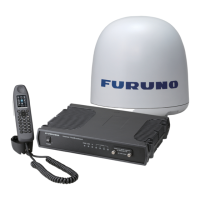5. WEB SOFTWARE
5-26
5. To display the detailed log, click the [Detail] button.
To return to the Voice call log, click the [Back] button.
*: See "IMPORTANT NOTICES" on page i.
6. To save the log to a CSV file, click the [Save CSV] button. (See step 3 in
paragraph 5.9.2 for details.) The Voice call log additionally records MSISDN*,
ICR, the Latitude and Longitude, CN0 and Message (only shown when there is an
event code).
*: See "IMPORTANT NOTICES" on page i.
Note 1: You can find the latitude and longitude at the time a call ended and RX signal
level by putting the cursor on the date on the Voice call log display. If there is no data
(old log, no GPS data) “--°--’--”, ---°--’--” appears.
Note 2: You can show the details of an event code by clicking the event code on the
Voice call log display. Click the [Back] button to return to Voice call log display.
Item Description
Date Displays the date when the communication starts.
Service Displays the communication service.
Direction Displays the communication direction.
Duration Displays the period for communication.
Caller Displays the access code of the caller. When the access code
is not needed, "- -" appears.
MSISDN* Displays the number of the Alternative MS-ISDN* for incoming
call. "Primary" is displayed in Primary MS-ISDN*.
Connection Displays the number of receiver. When an anonymous call is re-
ceived, "No-caller-ID" appears.
Internal call routing Displays the forwarded address with Internal call routing (ICR,
see paragraph 6.1.7).
• Extension number (four-digits): Succeeded forwarding.
• Extension number + X: Failed forwarding then disrupted on
shore.
Event code/ message Displays the event code and messages. When no event code,
"- -" appears.
Latitude Displays the position (Lat) at the time a communication ended.
Longitude Displays the position (Lon) at the time a communication ended.
Signal strength Displays the RX signal level (CN0) during communication.
+81XXXXXXXXX

